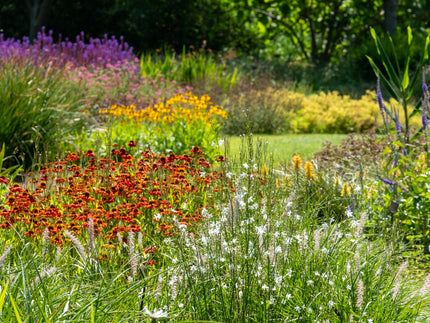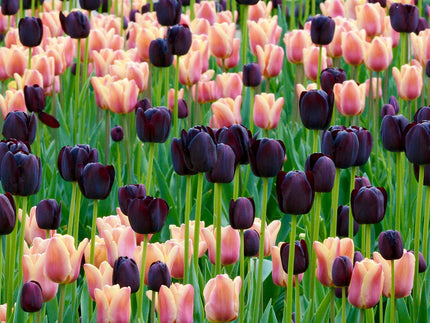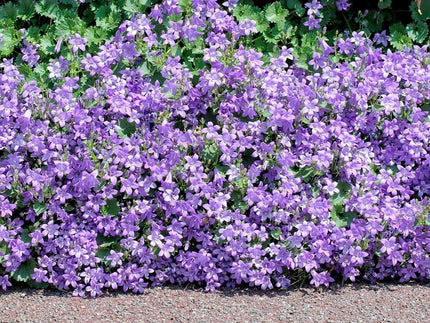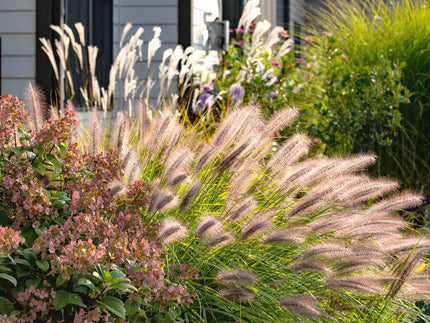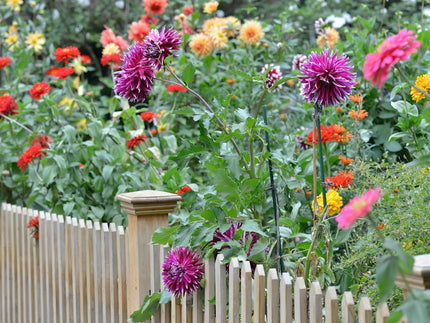Thyme
Thymus (Thyme) is a wide genus of hardy perennials and subshrubs. Although best known as a culinary herb, they make attractive garden plants too. Thymus praecox (Creeping Thyme) is a versatile spreading species, forming a carpet of aromatic, evergreen ground cover that provides useful year-round interest. In summer, the scented foliage is covered with tiny blooms which attract bees and other pollinators to a feast of nectar.
Creeping Thyme is a true sun-lover, flourishing in sun-baked spots on free draining soils once established, even in windy or exposed coastal locations. Perfect for spilling from troughs, inching between gaps in paving, covering wider areas of soil or softening the sharp edges of rockeries and gravel gardens. This adaptable, evergreen perennial is tough and reliable, quick to establish and easy to maintain. This is a low-maintenance plant, but will require initial care to get it settled in during the first season. Here's how to get your Thyme off to a good start:
How to plant
— Plant as soon as possible after delivery, ideally within a week. Creeping Thyme is supplied as a 9cm root ball plant, like a potted plant with soil on the roots. They should be watered upon arrival and positions in a bright, outdoor space. Thymus praecox root-balls are supplied between September to December for autumn planting, or February to May for spring planting.
— Root ball plants may be planted directly into a clear space in well prepared borders. Avoid planting them directly into a space which could become over-crowded by more established plants. Where growing conditions are more challenging, e.g. poor soil, dry areas or areas where there will be competition with other plants, root ball plants should be potted up and grown on in a sheltered spot outdoors in temporary pots until they are more established. They can be transplanted to borders once they have grown a stronger root system and produced top growth. It is important not to transplant them too soon - when they are ready to be transferred, the plant should should come out of the pot with the compost held intact by the roots.
— Plant bare roots or root balls so that the root system is fully submerged in the soil, leaving the top growth exposed above the soil surface. If planting root ball plants directly into a clear border, choose a sunny position with free-draining soil and space the plants 20-30cm apart. Add multipurpose compost to each planting hole to help the new roots grow. If you are planting in containers or potting up bare roots to grow-on, you should use multipurpose compost and a 15-20cm pot for each plant.
— Water-in after planting and continue to water regularly whenever to soil feels dry 3-4cm below the surface. Keep hydrated when in growth, particularly during the first year. Water only when necessary - over-watering may cause the plant to rot.
— Choose a position in full sun with well-drained, sandy or chalky soil. Once established, Creeping Thyme copes well in sun-baked or exposed positions.
— Thymus praecox are hardy perennials, there is no need to protect them from frost over winter although newly-potted plants may need some cover during cold snaps.
Aftercare:
— Creeping Thyme is evergreen, retaining its foliage throughout the winter months.
— When planting in autumn, they may produce some initial growth and then become dormant and stop making progress through winter - they will resume growing the following spring. If planting in spring, they should continue to grow and produce leaves through spring and summer. They do not always produce flowers in the first year.
— After flowering, lightly trim over the stems with secateurs to maintain a compact habit and promote bushy growth. Avoid cutting back into older, woody sections of the plant.
— In autumn, cut the stems down to around 5cm from soil surface. The plant will remain in a dormant state through winter and will grow back of its own accord the following spring.





















































































